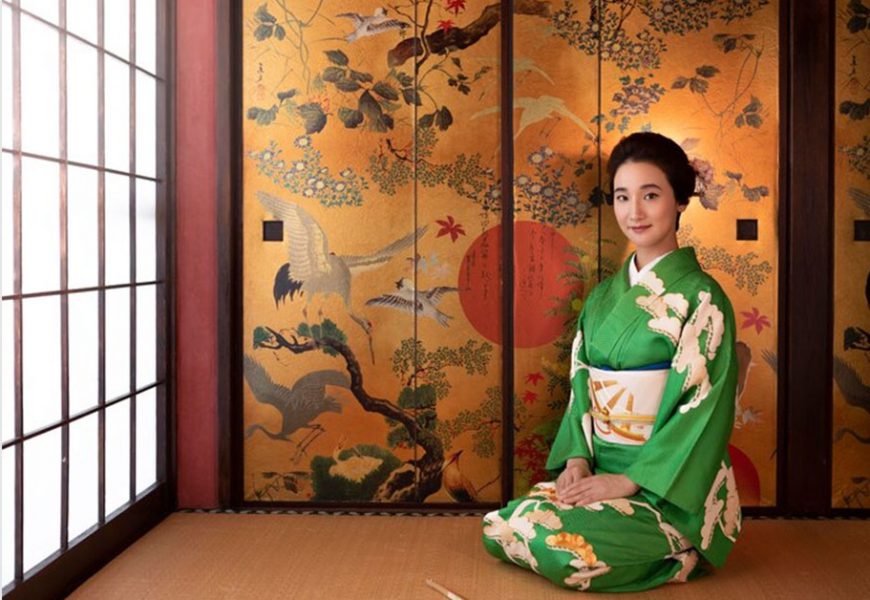The birthplace of manga, sushi, samurai and karate, Japan has captivated the world with its rich cultural heritage. Its multi-faceted culture has helped in shaping the global perception as a country with one of the most unique and interesting. It comes as no surprise that the Land of the Rising Sun attracts millions of tourists every year.
If you are among the many who plan to visit Japan sometime soon, be it for business or pleasure, you need to familiarise yourself with the traditions and customs of Japan to prevent yourself from experiencing culture shock and make your stay there worthwhile.
- Etiquette In Japanese Culture
- Bow When You Greet Someone
- Remove Your Shoes Before You Enter Someone’s House
- Pour For Everyone At The Table
- Slurping Is Encouraged
- The Positions The Chopsticks Are Placed Have Meanings
- Tipping Is Not Required
- Exchanging Business Card Is A Common Practice
- Always Be Polite
- Wear A Mask When You Are Sick
- Use Both Hands To Recieve Gifts
- Do Not Use Red Ink To Write Someone’s Name
- Bathe Before Entering Hot Springs
- Know Japanese Subway Etiquette
- Dress Conservatively
- Japanese Traditional Arts
- Japanese Communication Culture
- Japanese Work Culture
Etiquette In Japanese Culture

When in Japan, the following Japanese cultural etiquette will help you in blending in and enjoy a pleasant stay.
Bow When You Greet Someone
In Japan, the locals understand that foreigners do not bow when they greet people. However, it is a common practice for them, especially since it is a sign of respect given to the elders. The longer and deeper the bow, the more respect is given. A small nod indicates an informal greeting, usually done between friends and family members.
Remove Your Shoes Before You Enter Someone’s House
Japanese are known for maintaining cleanliness and hygiene, so much so that they prefer to leave their dust-covered shoes outside their house. Even in some restaurants, customers are expected to remove their shoes before entering. One of the main reasons this is a common custom in Japan is because Japanese people still eat and sleep on tatami mats, and they have to consistently keep their floors clean. In some Japanese homes, people have home skippers to be worn inside.
Pour For Everyone At The Table
It is a sign of respect and politeness to pour water, tea or sake for everyone present at the table while eating food. If you happen to be invited over for lunch or dinner at your Japanese friend’s house, ensure that you follow this table etiquette.
Slurping Is Encouraged
In Japan. Slurping on one’s food while eating, especially noodles, is welcomed because it is considered as a compliment given to the person who prepared it. However, they do not encourage burping or chewing too loudly.
The Positions The Chopsticks Are Placed Have Meanings
During a funeral in Japan, a person is not to rest his chopsticks on his plate or bowl if he is not eating. This is considered a bad omen. Even sharing chopsticks or passing food to others using your own chopsticks are taboos. You must remember to put your chopsticks down in front of you, with the end facing the right and the tips pointing toward the left once you have finished eating.
Tipping Is Not Required
In Japan, be it to a waiter or a taxi driver, it is not customary to tip people. In fact, many Japanese consider it rude or take it as an insult when people tip them.
Exchanging Business Card Is A Common Practice
In Japan, especially in the world of business, people often exchange business cards. So, we advise that you take enough cards with you when you visit Japan. If you do not have one, ensure that you make as many as possible.
Always Be Polite
In Japan, hard work, loyalty, politeness, and a sense of responsibility encapsulate the Japanese and their lifestyle. These revered qualities are imprinted in them at a young age. So, naturally, they are going to be polite and respectable towards the people they meet, new or old. So, remember to mind your manners and be thoughtful during your stay in Japan. Always thank or apologise when the time calls for it. To say “Thank you” in Japanese, go with “Arigatou.” To say “I am sorry” in Japanese, you can say “Gomen’nasai.”
Wear A Mask When You Are Sick
Japanese people are very much into hygiene, cleanliness and health. So, whenever someone is sick, it’s a civilised thing to do to wear a mask so that they don’t infect the others next to them. And now, living in the era of the coronavirus pandemic, we advise you to wear your mask when you are with others or outside.
Use Both Hands To Recieve Gifts
In Japan, it is considered rude to receive or give gifts to others using only one hand. So, remember to use both hands. Moreover, to appear modest, politely refuse the gift once or twice before accepting it.
Do Not Use Red Ink To Write Someone’s Name
While it is not so much of a cultural taboo to write someone’s name with red ink in Japan, it is still not a common practice. It is considered disrespectful. You could never go wrong with blue colour ink as it is one of the most-used ink colours for writing.
Bathe Before Entering Hot Springs
Known as Onsen, Japanese hot springs are scattered all over the country. Before entering it, you need to take a shower or a bath beforehand. These hot springs usually have commodities such as soap and shampoo in their washrooms to use. Moreover, do not be surprised when you are expected to remove all clothing when you dip in.
Know Japanese Subway Etiquette
The subways in Japan are known for their punctuality, which can be credited to the subway etiquette that the many people who use the trains follow. Subway users in Japan tend to avoid eating food inside the trains, and they enter and exit in an orderly manner without rushing others. Moreover, they avoid talking to each other or on their phones loudly, and they do not take up too much space, like leaving their bags on an empty seat where others should be sitting.
Dress Conservatively
While some people may dress in risque customs in cities like Tokyo and Harajuku, people in smaller cities or towns prefer to dress conservatively, be it during the day or night outings. When it comes to business, you can opt for dark-toned formal or semi0formal attires.
Japanese Traditional Arts

From Manga to tea ceremonies to martial Sumo wrestling, Japanese arts have mesmerised and dominated the world. Here are some common Japanese traditional arts you ought to know about before sailing off to the Land of the Rising Sun.
- Manga (マンガ): The origin of Manga (Japanese comic books and graphic novels) dates back to as early as the 12th century, and it was only in the 18th century that the word itself came to be used. Today, many manga series have captured the eyes, ears and souls of millions across the world. Many non-Japanese-speaking people are even taking Japanese language classes to read these comics in their original forms. One Piece, Naruto, Doraemon, and Dragon Ball are some examples of manga that have taken the world by storm.
- Tea Ceremony (Sadō/chadō 茶道): Influenced by Zen Buddhism, the Japanese tea ceremony is a traditional activity wherein people prepare and drink powered green tea while sitting on the tatami floor of a tearoom (specially designed for tea ceremonies). However, this ceremony also takes place outdoors or in any location where the hosts can make and serve tea to their guests, such as hotels or gardens. Today, there are many venues where tourists can experience this Japanese cultural activity.
- Osoji (おそじ): This Japanese New Year tradition is a deep-cleaning ritual that occurs either in December or at the beginning of January. During this time, the locals in Japan clean their houses and surroundings thoroughly to get rid of the dirt to invite deities into their homes.
- Toshikoshi soba ((年越し蕎麦): Every Ōmisoka, which takes place on the 31st of each year, Japanese all around the nation slurp on this scrumptious Japanese noodle bowl dish called toshikoshi soba. Dating back to the Edo period (1603-1867), this tradition is done with the belief that long soba noodles represent longevity.
- Karate (空手): Karate is a term almost everyone is familiar with. This slow-motion martial art was born in Okinawa, Japan, when the locals were not allowed to use weapons. It can be used to attack your opponents or defend yourself from them. To this day, Hollywood and other motion-picture industries make many movies and television series based on karate.
- Hanetsuki (羽根突き): Usually played on New Year by Japanese girls, Hanetsuki is a traditional Japanese game that involves hitting a hane (colourful shuttlecock) upwards with a hagoita (rectangle-shaped wooden paddle). The purpose of the game is to keep the hane keep it aloft as long as possible. They say that mosquitoes will stay away for an entire year from whoever wins the game.
- J-Pop: Originating back in the 1960s, Japanese pop music, commonly known as J-pop, is quite distinguishable from Western and other Asian pop sounds. The genres of this radio-friendly music range from pop-rock and idol-pop to jazz and folk. The fantasy-style dresses that most J-pop female artists wear have mesmerised audiences not just in Japan but also from many countries worldwide. Popular J-pop artists include AKB48 and Kyary Pamyu Pamyu, among many others.
- Shodō (書道): Shodō, which translates to the “way of writing”, is popular Japanese calligraphy. Influenced by Chinese calligraphy, this Japanese traditional art form has been passed on from generation to generation. While it is a type of written expression, it is so much more. It is also inspired by Zen Buddhism, evoking peace, harmony and wisdom.
Japanese Communication Culture

The Japanese communication culture revolves around one purpose: keeping peace and harmony. By nature, they are typically non-confrontational and avoid giving negative feedback or responses such as complaints, insults or making fun of others. When faced with any disagreement, they usually resort to indirect communication. In Japan, you should be able to read between the lines regarding direct and indirect communication.
Here are some Japanese communication etiquette you should be aware of or practice when you visit Japan.
- If you have any disagreement with someone, you should discuss it with them in private, not in the presence of others.
- Pay attention to the speaker’s non-verbal cues like their posture, body language or the tone they use.
- Do not directly refuse or give negative answers when refusing something.
- It is impolite to speak over someone who is speaking. Unless there is an opening or it is your time to speak, remain silent. Nod along when they are speaking to let them know you are listening.
- When you give someone compliments, do not overdo it as it can embarrass them.
- Maintain as minimum physical contact as possible. Unless it is unavoidable, try not to touch others in public or professional settings.
- Keep your distance when you are sitting or standing next to a stranger or someone you are not particularly close with.
- When speaking to some, try to maintain indirect eye contact as direct eye contact can seem intimidating. Do not stare directly into their eyes; focus on their chin or nose.
- If you see someone placing their hands at the back of their head, it usually means that they are embarrassed or indirectly disagree with something.
- If you see someone waving both their hands in front of them, be it their body or face, it usually indicates disagreement.
- Never point your finger at anyone or anything. It is considered disrespectful and rude. If you want to point something to someone, such as an object or a location, hold you your hand and gesture towards the direction.
- In Japan, people avoid public displays of intense emotions such as anger, especially at work, schools or other public places.
Japanese Work Culture

Japan’s strong work ethic is known worldwide with hard-working and loyal workers. Being professional colleagues and managers build a good working environment for you and improve job satisfaction. Here are some business etiquette tips for those travelling to Japan for work.
- Wear dark-toned business attire like a suit with a tie at work.
- Before making any decision, always get approval from your manager or supervisor.
- Do not call your colleagues by their first names.
- Do not start or engage in office gossip. People in Japan focus more on their work than small talk.
- As lunch breaks are considered as “own time”, the Japanese utilise it as best as they can by running errands, which is why not many people eat lunch together. If you want a group lunch, inform them about it a day prior.
- Always be early, if not on time. Being late for anything is a big no-no.
- Expect to be a part of a few or many work Nomikai, which is a drinking party. Be it welcoming a new employee or bidding farewell to another, or on other special occasions, there will be many events where drinking is involved.
- Teamwork is big in Japan. So, when it comes to projects, people tend to work as a team.
Conclusion: As Japan has many wonders to offer its visitors, it is only fair that we show them our respects when we visit by familiarising ourselves with their cultures and traditions. We hope this blog helps you in enjoying your stay in the Land of the Rising Sun.
Until next time, sayonara for now!




